Best Wi-Fi Routers for Smart Home [UK Guide]
Your Wi-Fi router sits at the heart of your smart home so it’s understandable that you’re considering upgrading. After all, the free router from your ISP sometimes just won’t cut it.
As download speeds seemingly increase every year, it’s important that your router keeps up with our demands and expectations. But, speed isn’t the only consideration, newer routers have app control, mesh networking and more.
In this guide we’ll share all the considerations and top routers to make your choice easier.
Table Of Contents
Quick Summary
In a rush? Here are our top recommended routers for your smart home:
- Linksys MR8300 – Great All-Round
- Netgear R9000 Nighthawk X10 – Best of the Best
- TP-Link Archer A7 – Budget Pick
- Amazon Eero – Best Mesh Wi-Fi Router
- Google Nest Wi-Fi Router – Worth a Mention
Smart Home Router Buying Guide
Buying a router might seem like a simple task, but when you get down to it, you’ll realise just how many things there are to consider and many of the specs can sound like an alien language. So, we’ve put together a ‘brief’ summary of the key features.
Here are SIX things to keep in mind:
1. Bandwidth - Look for AC1200 or higher
When you check the specifications of a router, there is a lot of industry jargon involved that might seem a bit confusing, but they are about to be demystified. When you see an AC number such as AC1750, this is a measure of how much bandwidth the router can carry across all of it’s frequencies.
It’s a slightly flawed metric as your network speed will also play a key role, but essentially the higher, the better. Luckily, most smart home devices (with the exception of cameras) don’t need substantial bandwidth so aim for at least AC1200.
2. Security - Look for WPA2 or WPA3
It is important to check for the security encryption of the router you want to purchase, you’ll see acronyms like WEP and WPA thrown around. WEP is an old security protocol so you should try to avoid this and look for one with WPA. Ideally you want WPA2 or WPA3 for optimum protection.
3. MU-MIMO - Routers with MU-MIMO perform better
This stands for ‘multiple user, multiple input, multiple output’ so you can see why the acronym is used. This is the users ability to retain multiple connection to multiple devices at the same time, great way to ensure your router works effectively with your smart home devices. Each device works at it’s own speed, rather than your whole network being held back by the slowest devices.
But higher consumption devices on the higher 5Ghz waves which can handle a higher bandwidth, then your smart home devices on the 2.5Ghz waves which has better coverage.
4. App Control and Smart Assistant Integration
Living in a smart home, you’ll be used to controlling your devices with apps or your voice. The newest generation of routers are also heading in this direction, with apps that allow you to check speeds, pause your internet, see connected devices and more. No more logging in to an unfriendly browser window.
Some routers also have Alexa or Google Assistant integration to add voice control features. As it stands, there doesn’t seem to be a huge amount you can do with your voice, but having this option should futureproof your device as more updates roll out.
5. Mesh Networking - A great add on for larger homes but not a necessity
If you live in a building with a lot of rooms which translates to having many walls, it’s advisable to invest in a router that supports mesh Wi-Fi. Mesh Wi-Fi means you can add further beacons around your home to extend your Wi-Fi coverage and you only need to be in range of one device. The router will switch you between access points to give you a strong connection which is something old Wi-Fi extenders never did.
6. Number of Bands - Look for dual band with the ability to choose between 2.4Ghz and 5Ghz when needed
The number of bands refers to the number of frequencies on which the router operates. A basic, single band router runs on 2.4Ghz, whereas a dual band runs on both 2.4Ghz and 5Ghz. A triband router has a second 5Ghz band, to make three in total.
Having more than one band is like having multiple Wi-Fi networks operating together, allowing you to spread bandwidth across them. We recommend at least dual band. High bandwidth tech, such as video gaming and streaming devices, are best suited to 5Ghz, whereas lower bandwidth devices, like smart home sensors and lights, are better suited to 2.4Ghz which offers greater coverage.
Some routers think they are being intelligent by switching your devices between 2.4Ghz and 5Ghz, however this is a nightmare for setting up smart home devices because of them can ONLY operate on 2.4Ghz and require your phone to be on the exact same network to set them up.
Therefore a key consideration when buying a router for a smart home, is that you can choose which frequency to connect to. There are two ways this can be done:
- Ability to split the 2.4Ghz and 5Ghz in to two separate Wi-Fi networks with different names (most common)
- Combine the networks, but with the ability to temporarily disable 5Ghz (innovative new concept)
One final note on the bands available, there is now a third frequency available for routers to use, 6Ghz, this will be called Wi-Fi 6E but currently there are no routers to support this.
Best Routers for Smart Home
Here are full reviews of our recommended smart home routers:
Linksys MR8300 – Great All-Round
This server provides a happy medium between performance and price, providing a smooth experience for most smart home setups.
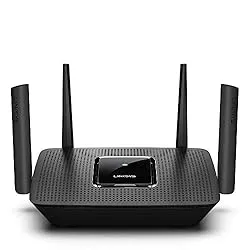
Built-in mesh Wi-Fi technology
Tri-band AC2200
MU-MIMO technology
Future-proof
App is slow
This router is one you can hardly fault as it has all the important features you will need to enjoy smooth access to the internet. It’s a tri-band router so it supports three frequencies across 2.4Ghz and 5Ghz to provide optimal speed and coverage. The bands can be split, allowing you to easily set up your smart home devices on the 2.4Ghz band whilst retaining two 5Ghz bands for streaming devices, consoles, laptops and more.
It has an AC2200 rating which is well above our recommended level. In addition to this, it has built-in mesh Wi-Fi technology so you can add beacons and further your coverage in future.
It makes use of MU-MIMO (Multi-User Multiple-Input Multiple-Output) technology allowing each device to operate at it’s own speed and prevents the network from slowing down.
It does have an app that allows you to control the router easily from your phone and also integrates with Alexa, allowing you to turn the internet on/off or ask for the Wi-Fi password with your voice. The app is probably the least impressive part of this router as it can be slow or unresponsive.
With this router, be assured that your unit is secure as you will receive automatic firmware updates. It works with any modem so you can make use of the one you have without thinking of an additional purchase. Overall, a great addition to your smart home.
Key Specs
- Max Bandwidth: AC2200
- Dual-band/Tri-band: Triband
- Mesh support: Yes
Netgear R9000 Nighthawk X10 – Best of the Best
If you’re willing to splash out, this is the top end device. It’s ideal for high bandwidth usage such as gaming or streaming, and works well as a NAS for your smart home security cameras.
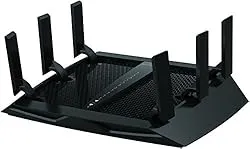
Quad-Core 1.7GHz processor
Tri-band AC7200
NAS capabilities perfect for a Plex media server or to store footage from smart home cameras
MU-MIMO technology
Requires modem
This router is truly the best one on the market and the one to pick if you’re willing to splash out. The Nighthawk range from Netgear is their premium line of routers, and this is the most feature-heavy one in the range.
It’s one of the industry’s fastest with a rating of AC7200, meaning a combined speed of up to 7.2Gbps across it’s three bands. You can be sure to enjoy ultra-smooth 4k streaming, instant download, and VR gaming with this router.
A full house does not have to mean slow internet because the MU-MIMO technology supports the use of multiple devices at the same time. It also has no less than 6 Ethernet ports giving you plenty of options for wired connections too.
It’s the only router on our list that supports 802.11ad which is superior to 802.11ac featured in the other devices. This is much more effective at sending Wi-Fi signals to your devices.
The device is perfect for use as NAS (Network Attached Storage) via the USB ports on the device, this is great if you plan to have a media server such as Plex for accessing entertainment throughout the house, but it also provides the option of local video storage from smart home devices. This is certainly the direction some smart security cameras and video doorbells are going with people becoming weary of storing their home camera footage in the cloud.
On your router, you can spot four antennas that help increase the signal range. When choosing a spot for your router, note that it should be slightly elevated. One downside is that it does not come with a modem but it’s likely you already own one.
Key Specs
- AC Number: AC7200
- Dual-band/Tri-band: Tri-band
- Mesh support: No
TP-Link Archer A7 – Budget Pick
This provides a significant upgrade on the free routers that your ISP sends, providing better performance without breaking the bank.
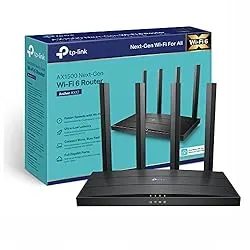
WPA2 secure
Dual band AC1750
Affordable
Alexa enabled
Requires modem
If you’re looking for an upgrade on the existing free router sent out with your broadband package, then this is a great start. It’s a dual-band Wi-Fi system with a combined speed of AC1750 which is higher than the average speed of AC1200, suitable for most households.
Three antennas in the back amplify signals and increase connection range. This makes it possible to use the router even if you’re a couple of rooms away from its location. It can also support multiple devices without slowing down the internet – guests can also enjoy using your fast internet.
It can be controlled via the Tether app which helps you set up your system easily and gives you access to parental control. Alexa compatibility allows this to be done using your voice too.
The smart connect feature allows the 2.4Ghz and 5Ghz bands to operate as one network to switch devices to the fastest connection. However, this can cause issues with smart home devices such as lightbulbs or plugs which can only use 2.4Ghz, so luckily smart connect can easily be turned off via the Tether app.
It has WPA2 wireless encryption which is the minimum we’d recommend and also supports a mesh network if you decide to expand it in future.
Key Specs
- AC Number: AC1750
- Dual-band/Tri-band: Dual-band
- Mesh support: Yes
- Security: WPA/WPA2
Amazon Eero – Best Mesh Wi-Fi Router
Easily the best mesh Wi-Fi ecosystem currently on the market which is easy to set up and connect additional nodes. Also makes it simple to set up smart devices on 2.4Ghz.
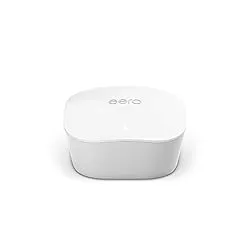
Easy to setup
TrueMesh technology to reach the furthest parts of your home
MU-MIMO support
Ability to disable the 5Ghz frequency to set up smart home devices
Expensive if you opt for the higher performance Eero Pro
Eero was already doing great things with their Wi-Fi routers, and now that the company has been purchased by Amazon, we only expect this to continue. The brand promises simple and reliable Wi-Fi that easily reaches every corner of your home.
They keep their promise about it being simple as you can complete the entire set up in a matter of minutes and adding additional nodes throughout the home is really easy. All of this is done via the app which also gives you access to performance data, devices to your network and the ability to monitor your kids’ internet usage.
One of the great features of Eero is the ability to temporarily disable the 5Ghz frequency, this is a really innovative way to sort out the issues encountered when setting up new smart home devices that require your phone to be on 2.4Ghz. This is a far better solution than having two separate networks as other routers require.
You will need to select the right device, there is both an Eero and a slightly more expensive Eero Pro. Essentially the Eero Pro is the better of the two, with a higher bandwidth capability and tri band technology. It also has a slightly larger coverage up to 160m2 per device, compared to the standard Eero’s 140m2.
Of course, being an Amazon-owned company, it integrates really well with Alexa for voice control.
Key Specs
- Dual-band/Tri-band: Dual-band
- Mesh support: Yes
Google Nest Wi-Fi Router – Worth a Mention
Google’s version of a mesh Wi-Fi system is sleek to look at and has more than enough bandwidth for your needs. Plus the Wi-Fi points act as Google Assistant smart speakers.
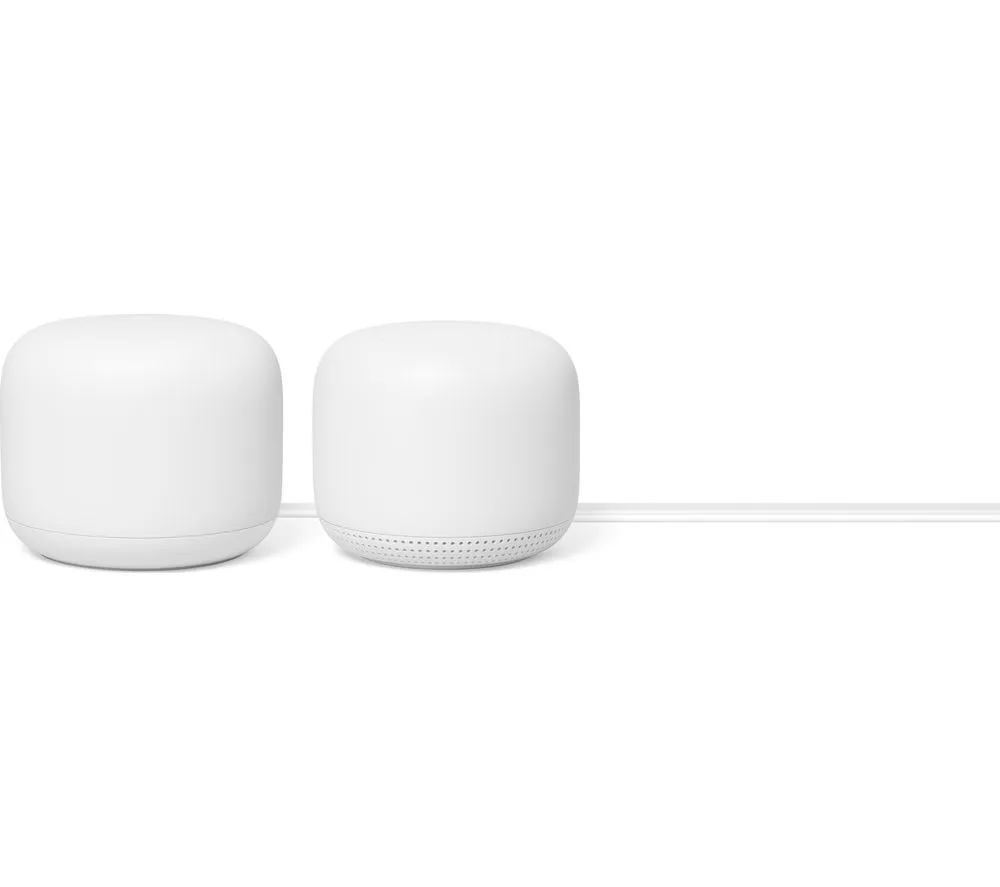
Google Assistant built-in
Latest WPA3 security
Dual band AC2200
Does not have MU-MIMO
Ethernet ports hard to reach
Expensive
We are major fans of the Google ecosystem here at Smart Home Insider, and whilst we admit that Amazon has the better router, we couldn’t exclude Google’s version.
The Nest router sits at the centre of the network with Wi-Fi points that can be spread throughout your home to provide even coverage. The router itself is dual-band and combined with one Wi-Fi point has an AC2200 rating which is more than adequate for a smart home.
We like that the router and Wi-Fi points are sleek with the cables hidden away underneath, although we admit that this makes it a little hard to get to the ethernet ports. The Wi-Fi points can also be used as a smart speaker with built in Google Assistant. This is great if you’d like to expand your smart assistant throughout the home without buying extra speakers.
The connection is super secure with the highest WPA3 wireless encryption provided and everything can be controlled from the Google Wi-Fi app. There are a few notable things missing from this set up, including MU-MIMO and the ability to separate the two bands in to 2.4Ghz and 5Ghz which is why overall we prefer Amazon Eero for a mesh network.
Key Specs
- AC Number: AC2200
- Dual-band/Tri-band: Dual-band
- Mesh support: Yes
- Security: WPA3
Featured image credit: Azamat E from Pexels